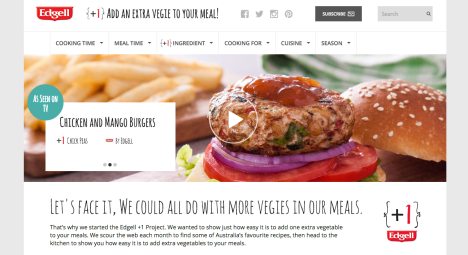Edgell gets edgy as 100-year-old brand looks to modernise with Plus One social experiment
Steve Jones examines how a century old FMCG brand embraced social media to help bolster its floundering sales.
According to the Australian Dictionary of Biography, next year marks the 110th anniversary of Gordon Edgell’s first dalliance with vegetables.
It was in 1906 that he and wife Elsie bought Bradwardine, near Bathurst, from pastoralist and politician Sir Francis Suttor. And it was here where Gordon planted a hundred acres of apples, pears and asparagus using cutting edge farming technology, including mechanical cultivation.
Twenty years later, in 1926, he opened his first cannery before registering Gordon Edgell and Sons as a public company in 1930.
An Australian icon-in-the-making was born.
The problem
It would not be unfair to suggest that Edgell has gradually lost its cutting edge in the intervening 80 years, with the growth of organic, fresh and River Cottage-style home grown cooking rendering the brand – and product – dated.
But a marketing-led renaissance has taken hold of the brand over the past 18 months. As it fought to stay in the consideration set of a more sophisticated customer, Edgell has been forced to adopt a new approach, one where traditional marketing has still been used but with the principal aim of driving consumers to new digital platforms.
At the core of this was a concerted push to “socialise” Edgell by building a presence on social media.
Edgell senior brand manager Ben Dixon admitted it was under no illusions how such a traditional category as shelf vegetables was viewed by consumers as it sought to modernise its image.
“Edgell is an iconic Australian brand and the market leader in a traditional mainstream grocery category,” he said. “But we knew that shelf vegetables – and us being the market leader – have been seen as a bit old fashioned and, more importantly, less relevant to the kinds of meals people are preparing today.
“But we also knew that nine out of 10 households do have some sort of canned vegetables so we do have a wide audience across all grocery buyers.
“Our objective was to become more progressive and develop a brand and product that is relevant to our consumer’s lifestyles. We needed to become inspiring and as market leader we had the opportunity to break the old fashioned nature of the brand and category.”
Central to the plan was the creation of Edgell Plus One, a project and website brought to life in partnership with Melbourne-based digital agency Hardhat.
The aim was to create a content-rich hub containing modern-day recipes that required that addition of one vegetable, hence Edgell Plus One.
The strategy to modernise, and the desire to inspire, required “reach”, according to Dixon, with the aim of driving traffic to the Edgell Plus One website and providing consumers with not only a reason to buy an Edgell product but a reason to pick the brand off the shelves more often.
“To become more relevant and accessible we needed to move away from traditional forms of media, we needed to engage and embrace digital platforms,” he said.
With Hardhat’s guidance, Edgell began reshaping the brand.
‘Stay humble’
At the heart of the repositioning was a relatively simple strategy, Hardhat owner and director of strategy Dan Monheit said. And that was to create recipes that could be easily enhanced “with one more vegetable”.
“When we looked at the whole issue of Edgell Plus One it was important we stayed humble, that we didn’t get ahead of ourselves and somehow think we were going to create new consumer behaviour,” he said. “We just wanted to find recipes that people already loved.
“We already knew that people wanted to put more veggies in their diet so we set out to give them an easy way to do just that.”
Dixon said: “From a social and digital standpoint we predominantly used Facebook and were one of the first to adopt multi-product link ads and were using video within Facebook. New Idea was also posting our recipes and using their social content network to get our message out.
“The Facebook element straight away achieved fantastic reach for us and more importantly found acquisition through on-going conversations. We also used Outbrain to drive people directly from digital platforms to our website.
“We built an organic community with very minimal spend and consumers were coming on board. But then we though, ‘this insight is clearly bigger than just digital and social media’ hence why we expanded to get reach through traditional media like TV.”
Back on TV
Edgell then embarked on tried and tested marketing in the form of TV ads, created by BWM, accompanied by heavily branded cooking slots on Seven’s Morning Show, to further drive visits to the site and social platforms. Full page ads were also taken out in lifestyle magazines, including New Idea.
Huckleberry was the media buyer for the campaign.
https://www.youtube.com/watch?v=8tpadhwzyXs
“We successfully developed this digital platform and to get additional reach we used traditional forms of media,” Dixon said, adding it was the first time in many years the brand had appeared on TV.
Monheit said: “The irony was that it took a digital platform to get the brand back on TV.”
He identified Outbrain as a particularly successful way it generated traffic, describing volumes as “amazing”.
“We developed a series of specially written headlines, and accompanying content, that were placed alongside relevant content on many of Australia’s most popular recipe sites,” he said. “During this period Outbrain sources generated a significant portion of total traffic to Edgell Plus One and contributed to a considerable increase in recipe views and sign ups. ”
Edgell now has a presence on Pinterest, Twitter and Instagram, as well as Facebook, as the brand aims to communicate and resonate with a cross-section of the market.
While traditional elements of the marketing were geared towards the 40 plus market – “the heavy buyers with older kids in the house” – the fact Edgell was on a wide range of social platforms meant it was age agnostic, Dixon said.
“That was very intentional. We didn’t want to target mums just looking for a dinner solution for their kids,” he explained. “We were looking for anyone, at any time, of any demographic.”
The results
Edgell, citing Nielsen data, claimed the digital and social focus through Edgell Plus One has seen a double digit rise in market share.
Dixon said Edgell had no reservations about making the switch to a digital and social led strategy, and denied the staid nature of the product may not have transitioned well to modern day marketing. On the contrary, trust developed over many decades meant Edgell was well placed to ensure cut through.
“If you’re a traditional brand like Edgell or a cutting edge brand like Apple, everyone is looking for the message through social media,” he said. “We didn’t fear putting Edgell into the social realm because people trust it and every household in Australia engages Edgell and the category at some point during the year.”
The trust of the brand has been further magnified by the use of online food bloggers and chefs, who attract huge numbers of followers and who are also highly trusted, he added.
“In the last couple of months we have been engaging with bloggers and building that up as another piece of content,” he said
Monheit added Edgell was co-creating content with bloggers, rather than simply paying for branded content.
“Rather than us saying ‘can you post about us on your blog’ we have said we want to collate great recipes that Australians are going to love. Bloggers have great audiences with great recipes so we want to bring that to our site and our community,” he said.
‘Reach and frequency’
Monheit described the approach as “pretty spectacular” for an FMCG brand with 100 years of history, but added there is now no real alternative but to aggressively pursue a digital and social approach.
“FMCG brands are built on reach and frequency,” he said. “We are not going to get the same reach and frequency metrics through traditional media that we would have 20 years ago so if we want to be in front of people it’s got to be online and through social media.”
He said the way Edgell approached its transition from traditional to digital was a lesson to other brands who are contemplating their own marketing evolution.
The answer, Monheit said, is not to let change descend into fear.
“The challenge, and this is true for any business, is to allow the unknown to inspire you, not paralyse you,” he said. “Traditional brands are used to doing things where everything is in the can, it’s done, locked away and everyone has signed off on it. You know when it’s going to run because you have seen the schedule.
“With digital and social there are lots of things you don’t know until you try. The secret is not to let that paralyse you but to say let’s get in there and try it.
“Edgell almost caught us off guard at how willingly they jumped at this.”
Dixon declined to reveal the split between traditional and digital/social marketing but said what started out as an experiment for Edgell has now become a central plank of its marketing.
“Canned veg is not a small category. We know it’s maturing and veggies in cans can sometimes be seen as a compromise. For us it’s all about staying relevant and that means making sure that every time people are creating a meal they realise how easy it is to add a vegetable in a pre-produced format.”
He added: “Digital has gone from experimental expenditure to a key part of our communications strategy alongside traditional media. We have seen the benefits of that approach and we’ll continue to do that. It will no longer be experimental and our media spend will be spread between traditional media, digital and social.”
You have to wonder what Gordon would have thought of it all.
Steve Jones




Great case study article and good to see an Aussie FMCG venturing into digital and social and not always contextual recipe or foodie sites.
+1 Dixon
Of course the tv ads and cooking slot and the magazine ads did nothing….. just the digital activity worked….. .
Great story that shows even in FMCG with all the margin pressure, venturing a little can reap large rewards. I guess the pressure is to bring the activation full circle and connect +1 with people as they walk the aisles at Coles. Any ideas?